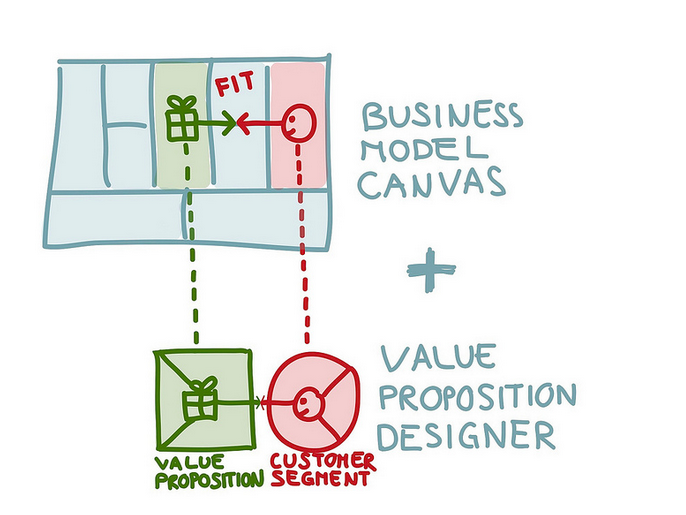10 Signs that it is time to update your business model
In simple words, a business model is the way in which a company creates, delivers, and captures market value. There are different tools to study...
In 2008 Alexander Osterwalder (business scientist and co-founder of Strategyzer) developed a tool to facilitate the analysis and visualization of business models. Since then, the model canvas has obtained great acceptance thanks to its simple approach to summarize and visualize different strategic decisions. Proof of the tool's popularity is the 209 million results displayed on Google when a tool search is performed.
Although we have such a powerful tool and its use has been disclosed in the business and academic world, we continue to find generic business models with little differentiation. Why do we keep getting the same results? Among other factors, in most cases, they find models lacking a robust value proposition, the result of a thorough knowledge of customers. It is vitally important that you internalize the value proposition as all business model decisions must revolve around it. Alexander Osterwalder developed in 2014 the canvas of the value proposition, a systematic tool that makes it easier to achieve the fit between the requirements of the market segments and the value proposition of the company.
The benefits of the value proposition canvas and the business model canvas are:
Each of the nine blocks on the business model canvas answers important questions about your business strategy. While the analysis should be simple, we recommend using the DMAIC problem-solving methodology when you need to sit down to define or redefine your company's business model, a business unit, or a new product or service.

The DMAIC is the methodology of continuous improvement by its acronym in English. Each of the letters represents a phase of the process.
In the Define stage, we plan the project, whether it is to define or improve the business model or the value proposition. In this phase you must determine:
Then the team must advance to the definition phase:
In the Measure the team stage you must gain a deep understanding of customer satisfaction and how the company measures it. Understand the results and their causes by making a cause-effect relationship with customer analysis. Measure the factors that affect customer satisfaction, they can be internal (processes, policies, culture, etc.) or external (market, expectations, etc). If your company still does not measure customer satisfaction, it is time to define the metrics and start the effort. Remember what is not measured is not improved. This stage is important as it represents the basis against which we will measure the improvements to be implemented. In ROI and CX metrics you can find a measurement guide that you can consider starting to use
Once we have the universe of information and we also know what the customer satisfaction measurements are, we proceed to rely on the value proposition canvases and the business model to perform the Analyze stage. The correct way to perform the analysis is by dividing the canvas of the business model into two large units of analysis: the right part (or the market part) and the left part (internal company analysis).
Analysis of the right part (or the market)
This section is where the innovation of the business model occurs, that's why we start the analysis. It should start with the analysis of the value proposition, due to the interdependence between it and the rest of the business model decisions. The canvas of the value proposition helps us visualize the existence of the fit between the offer and the needs of the customers.
Once you have the current market segment and value proposition mapping, it is time to continue mapping the rest of the blocks on the right side of the business model canvas (channels, customer relationships and revenue streams).
Analysis of the left part (internal analysis of the company)
Once we know how we generate, deliver and capture the value we proceed to align the internal part of the company to perform the right part of the canvas efficiently. This stage can be enriched with the analysis of the company's value chain.
Note: Some teams may decide to carry out the activities of the Analyze stage in the Define stage so that the information they raise from the client's voice does not generate noise at this time. If your team makes the above decision, use this phase to only analyze problems within your current model.
Like the analysis of the canvas of the business model, we suggest performing the stage Improve first in the part the right part (or the market part) of the canvas of the business model and then in the left part (internal analysis of the company).
Achieving the fit between the customer segment and the value proposition. Get to work with the proposed update. You can use the following questions as a guide:
What are the jobs that your customers are trying to do?
The jobs represent the tasks that customers are trying to perform and are why they "hire" their solutions (products/services).
What is the origin of your client's pain?
By pain, we understand that it is an event that decreases the customer experience. Some useful tools can be the Jobs to be Done, the strategy canvas, and the customer experience map. Some questions that will allow your team to investigate the pains of their clients are:
What are the sources of happiness for your customers?
For happiness or gain we mean the results and benefits that your customers want. Some profits are required, expected or desired, and some will surprise your customers. Some questions that will allow your team to inquire into the profits of their customers are:
With the answers of the previous questions (which must be the result of the client's voice in the Define stage), generate a solution (product or service) that increases the sources of happiness of your clients, provides pain relievers and helps the client to perform functional, social and emotional work. At this point it is important to clarify that the solution may focus on some of the work or some sources of happiness or pain; Not necessarily at all. The above is one of the first strategic decisions to be taken.
Now that you have your proposed value proposition canvas, which contains a true fit between the customer segment and value proposition, continue the analysis of the right side of the business model canvas and finally find all the efficiencies of the value chain by analyzing The left side. Use as a guide and introduction to business model innovation to make improvements to your current model. Importantly do not forget that the blocks are completed taking into account that they must strengthen each other with the value proposition.
C - Controlling the results over time
Customer tastes and preferences change day by day and customer expectations move from one industry to another. The Control stage helps us monitor if our value proposition is still valid and delighting our customers. Analyze your key indicators regarding customers and the objectives defined in the Define stage. Has your NPS improved? Have you improved your customers' repurchase? Have you added new clients to your portfolio? Has the word of mouth increased? In case you are not reaching the objectives, take action by performing the DMAIC cycle again.
Conclusion
Although there is enough literature on the canvas of the business model, we propose to focus on the greatest attention of the exercise on analyzing and improving the value proposition using the canvas of the value proposition. An opportunity for improvement in which we work is to use an engineering methodology that allows an orderly framework to achieve continuous improvement. This is because the business model must evolve day by day, as the tastes and preferences of the clients change, with the speed that the central assets of the industries are threatened and other factors that affect the business.

In simple words, a business model is the way in which a company creates, delivers, and captures market value. There are different tools to study...

Have you ever heard of data governance? Do you know what it is and how it works? Data governance is a booming topic. Many people are now interested...

Many companies are clear about their promise to their customers; some even know why the client wants them since they maintain good communication with...